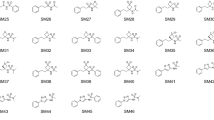Abstract
Molecular docking techniques are widely used in computational drug discovery. Most of these techniques simulate the way that a ligand interacts with a protein target focusing on one binding site. Blind docking is a recent technique which is designed to search the entire surface of the protein to discover new interesting binding sites. Unfortunately, this new docking method is computationally more intensive since its complexity grows exponentially according to the number of binding sites, which severely limits its utilization in practice. This paper shows a road-map for an efficient parallelization of the calculation of the solvation energy which represents the most time-consuming part of the scoring function. The latter constitutes a bottleneck in both simple and blind docking. The proposed parallelization approach aims to efficiently exploit the large computing power offered by the latest NVIDIA GPU architectures. Toward this goal, we propose a new parallel approach that exploits the Hyper-Q capability to compute several GPU kernels simultaneously, thereby speedingup the computation process and maximizing the GPU utilization. The obtained results show the huge benefit of exploiting the latest GPU architectures as compared to serial and parallel CPU approaches. Indeed, for 100 binding sites, our results show an average speedup of 186\(\times\) as compared to the serial implementation, and 10\(\times\) as compared to the multi-core CPU version. Moreover, an experimental comparison shows the superiority of our approach over the state of the art.






Similar content being viewed by others
References
Bleiweiss A (2008) Gpu accelerated pathfinding. In: Proceedings of the 23rd ACM SIGGRAPH/EUROGRAPHICS Symposium on Graphics Hardware, Eurographics Association, pp 65–74
Bradley T (2012) Hyper-q example. NVidia Corporation. Whitepaper v1. 0
Eisenberg D, McLachlan AD (1986) Solvation energy in protein folding and binding. Nature 319(6050):199–203
Fang J, Varbanescu AL, Imbernon B, Cecilia JM, Sánchez HEP (2014) Parallel computation of non-bonded interactions in drug discovery: Nvidia gpus vs. intel xeon phi. In: IWBBIO, pp 579–588
Ferreira LG, dos Santos RN, Oliva G, Andricopulo AD (2015) Molecular docking and structure-based drug design strategies. Molecules 20(7):13384–13421. https://doi.org/10.3390/molecules200713384, http://www.mdpi.com/1420-3049/20/7/13384
GPGPU: CUDA zone. https://developer.nvidia.com/cuda-zone
Green S (2010) Particle simulation using cuda. NVIDIA Whitepaper 6:121–128
Hetenyi C, van der Spoel D (2006) Blind docking of drug-sized compounds to proteins with up to a thousand residues. FEBS Lett 580(5):1447–1450. https://doi.org/10.1016/j.febslet.2006.01.074
Hetényi C, van der Spoel D (2002) Efficient docking of peptides to proteins without prior knowledge of the binding site. Protein Sci 11(7):1729–1737. https://doi.org/10.1110/ps.0202302
Huang N, Shoichet BK, Irwin JJ (2006) Benchmarking sets for molecular docking. J Med Chem 49(23):6789–6801. https://doi.org/10.1021/jm0608356 PMID: 17154509
Huey R, Morris GM, Olson AJ, Goodsell DS (2007) A semiempirical free energy force field with charge-based desolvation. J Comput Chem 28(6):1145–1152
Imbernón B, Prades J, Giménez D, Cecilia JM, Silla F (2018) Enhancing large-scale docking simulation on heterogeneous systems: an mpi vs rcuda study. Future Gen Comput Syst 79:26–37
Kannan S, Ganji R (2010) Porting autodock to cuda. In: IEEE Congress on Evolutionary Computation, pp 1–8. https://doi.org/10.1109/CEC.2010.5586277
Kirk DB, Wen-Mei WH (2016) Programming massively parallel processors: a hands-on approach. Morgan Kaufmann, Burlington
Lavecchia A, Di Giovanni C (2013) Virtual screening strategies in drug discovery: a critical review. Curr Med Chem 20(23):2839–2860
Morris GM, Goodsell DS, Halliday RS, Huey R, Hart WE, Belew RK, Olson AJ et al (1998) Automated docking using a lamarckian genetic algorithm and an empirical binding free energy function. J Comput Chem 19(14):1639–1662
Morris GM, Huey R, Lindstrom W, Sanner MF, Belew RK, Goodsell DS, Olson AJ (2009) Autodock4 and autodocktools4: automated docking with selective receptor flexibility. J Comput Chem 30(16):2785–2791
Nickolls J, Dally WJ (2010) The gpu computing era. IEEE Micro 30(2):56–69. https://doi.org/10.1109/MM.2010.41
NVIDIA: Pascal architecture. https://devblogs.nvidia.com/inside-pascal/
NVIDIA: Thrust. http://docs.nvidia.com/cuda/thrust/index.html
NVIDIA AUTOMOTIVE: Giving Cars the Power to See, Think, and Learn . http://www.nvidia.com/object/drive-automotive-technology.html
NVIDIA Science and Medical Imaging: Accelerating Science and Medical Imaging with NVIDIA GPUS -/science-and-medical. http://www.nvidia.com/object/science-and-medical-imaging.html
NVIDIA Whitepaper: NVIDIA Tesla P100 The Most Advanced Datacenter Accelerator Ever Built . https://images.nvidia.com/content/pdf/tesla/whitepaper/pascal-architecture-whitepaper.pdf
OpenMP Architecture Review Board (2017) The OpenMP Specification. http://www.openmp.org, (accessed, April, 2th, 2017)
Owens JD, Houston M, Luebke D, Green S, Stone JE, Phillips JC (2008) Gpu computing. Proc IEEE 96(5):879–899
Saadi H, Nouali-Taboudjemat N, Rahmoun A, Imbernón B, Peréz-Sánchez H, Cecilia JM (2017) Parallel desolvation energy term calculation for blind docking on gpu architectures. In: Parallel Processing Workshops (ICPPW), 2017 46th International Conference on, IEEE, pp 16–22
Sanders J, Kandrot E (2010) CUDA by example: an introduction to general-purpose GPU programming, portable documents. Addison-Wesley Professional, Boston
Sukhwani B, Herbordt MC (2009) Gpu acceleration of a production molecular docking code. In: Proceedings of 2nd Workshop on General Purpose Processing on Graphics Processing Units, ACM, pp 19–27
The Scripps Research Institute. TSRI: Desolvation Free Energy Term in AutoDock 4. http://autodock.scripps.edu/resources/science/autodock-4-desolvation-free-energy//
Zhang Q, Wang J, Guerrero GD, Cecilia JM, García JM, Li Y, Pérez-Sánchez H, Hou T (2013) Accelerated conformational entropy calculations using graphic processing units. J Chem Inform Model 53(8):2057–2064
Acknowledgements
This work was partially supported by the Fundacin Séneca del Centro de Coordinación de la Investigación de la Región de Murcia under Projects 20988/PI/18, 20813/PI/18 and 20524/PDC/18, and by the grants from the Spanish Ministry of Economy and Competitiveness (TIN2016-80565-R and CTQ2017-87974-R). The authors thankfully acknowledge the computer resources at CTE-POWER and the technical support provided by Barcelona Supercomputing Center - Centro Nacional de Supercomputación (RES-BCV-2018-3-0008).
Author information
Authors and Affiliations
Corresponding author
Additional information
Publisher's Note
Publisher's Note Springer Nature remains neutral with regard to jurisdictional claims in published maps and institutional affiliations.
Scoring function: A function used to approximately predict the binding affinity between two molecules when docking to each other.
Rights and permissions
About this article
Cite this article
Saadi, H., Nouali Taboudjemat, N., Rahmoun, A. et al. Efficient GPU-based parallelization of solvation calculation for the blind docking problem. J Supercomput 76, 1980–1998 (2020). https://doi.org/10.1007/s11227-019-02834-5
Published:
Issue Date:
DOI: https://doi.org/10.1007/s11227-019-02834-5




